Analysis of Therapeutic Nursing: Gibbs Model and NMBA Standards
VerifiedAdded on 2021/05/30
|8
|2022
|1638
Report
AI Summary
This report provides a detailed reflection on a video depicting a nursing student interacting with a patient, using the Gibbs model of reflection. The student describes the interaction, including the nurse's effective communication skills and the establishment of a therapeutic relationship, highlighting the importance of obtaining patient consent and maintaining professional boundaries. The report evaluates the interaction, noting the nurse's kindness and adherence to NMBA standards, particularly Standard 2, while also pointing out areas for improvement, such as the need for increased empathy. Through analysis, the report emphasizes the significance of therapeutic relationships and effective communication in fostering patient trust and compliance. The conclusion outlines the student's action plan to enhance their own skills in patient care, including further study of evidence-based practices and participation in workshops to improve emotional intelligence and communication. The assignment demonstrates the application of reflective practice to improve nursing skills and patient outcomes.
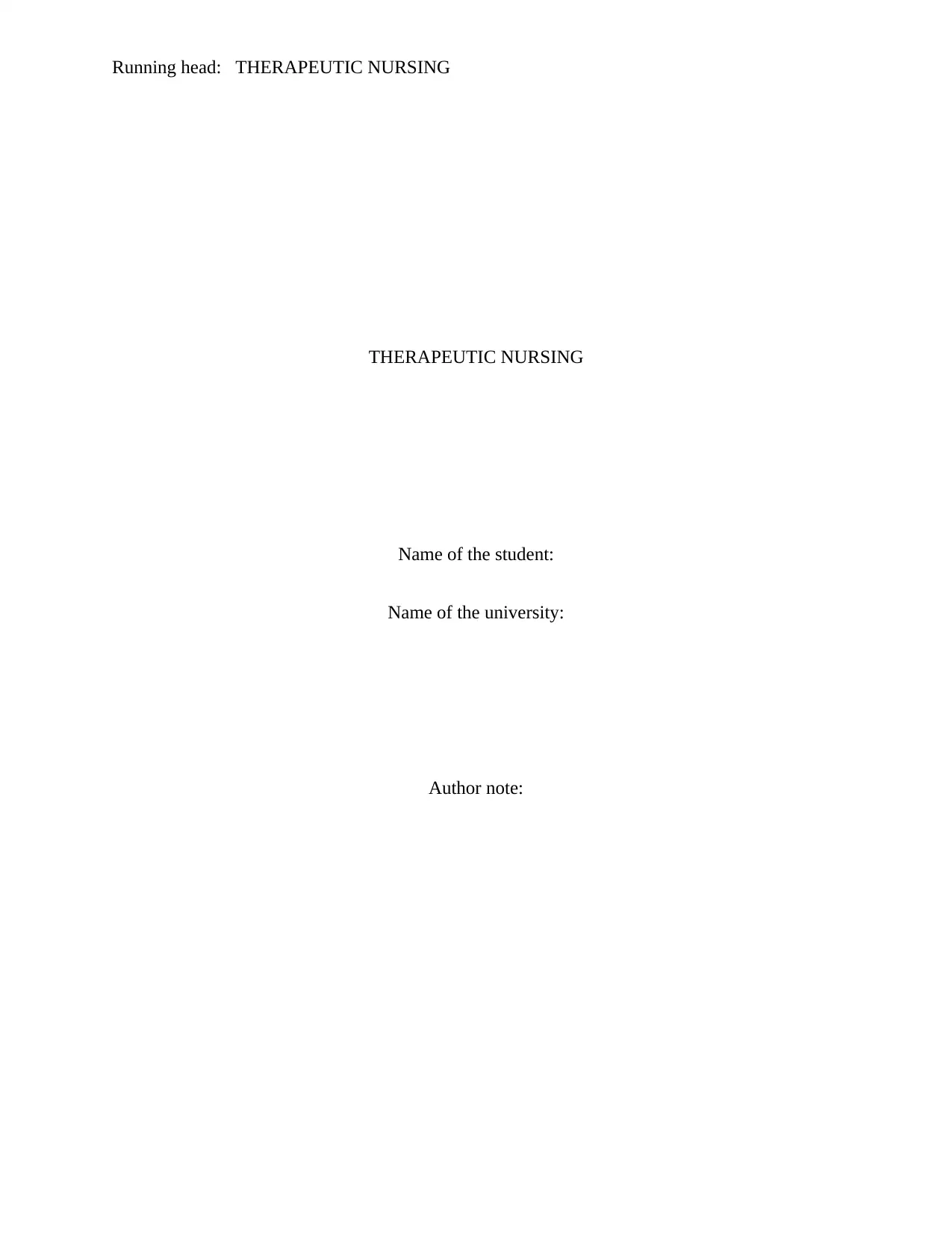
Running head: THERAPEUTIC NURSING
THERAPEUTIC NURSING
Name of the student:
Name of the university:
Author note:
THERAPEUTIC NURSING
Name of the student:
Name of the university:
Author note:
Paraphrase This Document
Need a fresh take? Get an instant paraphrase of this document with our AI Paraphraser
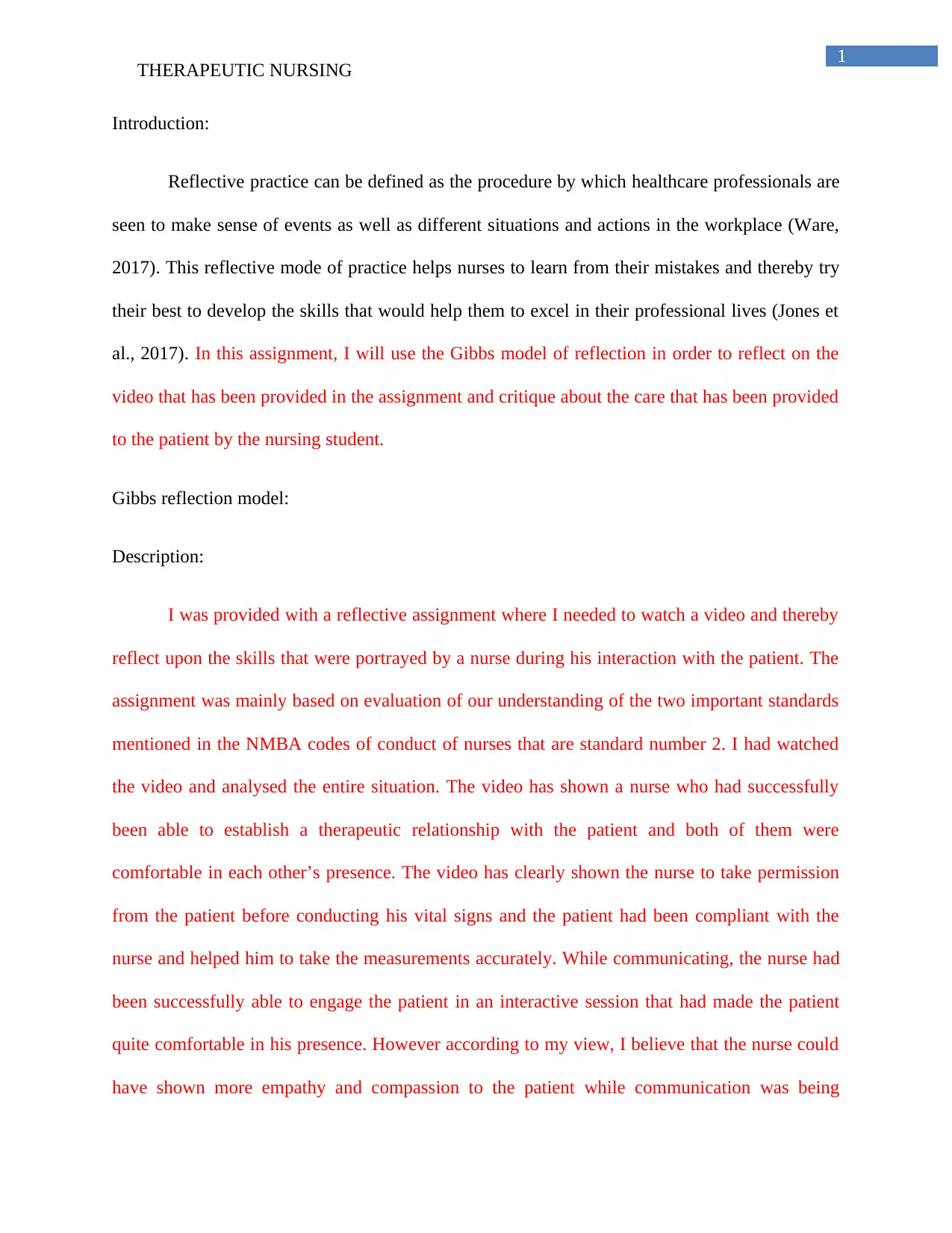
1
THERAPEUTIC NURSING
Introduction:
Reflective practice can be defined as the procedure by which healthcare professionals are
seen to make sense of events as well as different situations and actions in the workplace (Ware,
2017). This reflective mode of practice helps nurses to learn from their mistakes and thereby try
their best to develop the skills that would help them to excel in their professional lives (Jones et
al., 2017). In this assignment, I will use the Gibbs model of reflection in order to reflect on the
video that has been provided in the assignment and critique about the care that has been provided
to the patient by the nursing student.
Gibbs reflection model:
Description:
I was provided with a reflective assignment where I needed to watch a video and thereby
reflect upon the skills that were portrayed by a nurse during his interaction with the patient. The
assignment was mainly based on evaluation of our understanding of the two important standards
mentioned in the NMBA codes of conduct of nurses that are standard number 2. I had watched
the video and analysed the entire situation. The video has shown a nurse who had successfully
been able to establish a therapeutic relationship with the patient and both of them were
comfortable in each other’s presence. The video has clearly shown the nurse to take permission
from the patient before conducting his vital signs and the patient had been compliant with the
nurse and helped him to take the measurements accurately. While communicating, the nurse had
been successfully able to engage the patient in an interactive session that had made the patient
quite comfortable in his presence. However according to my view, I believe that the nurse could
have shown more empathy and compassion to the patient while communication was being
THERAPEUTIC NURSING
Introduction:
Reflective practice can be defined as the procedure by which healthcare professionals are
seen to make sense of events as well as different situations and actions in the workplace (Ware,
2017). This reflective mode of practice helps nurses to learn from their mistakes and thereby try
their best to develop the skills that would help them to excel in their professional lives (Jones et
al., 2017). In this assignment, I will use the Gibbs model of reflection in order to reflect on the
video that has been provided in the assignment and critique about the care that has been provided
to the patient by the nursing student.
Gibbs reflection model:
Description:
I was provided with a reflective assignment where I needed to watch a video and thereby
reflect upon the skills that were portrayed by a nurse during his interaction with the patient. The
assignment was mainly based on evaluation of our understanding of the two important standards
mentioned in the NMBA codes of conduct of nurses that are standard number 2. I had watched
the video and analysed the entire situation. The video has shown a nurse who had successfully
been able to establish a therapeutic relationship with the patient and both of them were
comfortable in each other’s presence. The video has clearly shown the nurse to take permission
from the patient before conducting his vital signs and the patient had been compliant with the
nurse and helped him to take the measurements accurately. While communicating, the nurse had
been successfully able to engage the patient in an interactive session that had made the patient
quite comfortable in his presence. However according to my view, I believe that the nurse could
have shown more empathy and compassion to the patient while communication was being
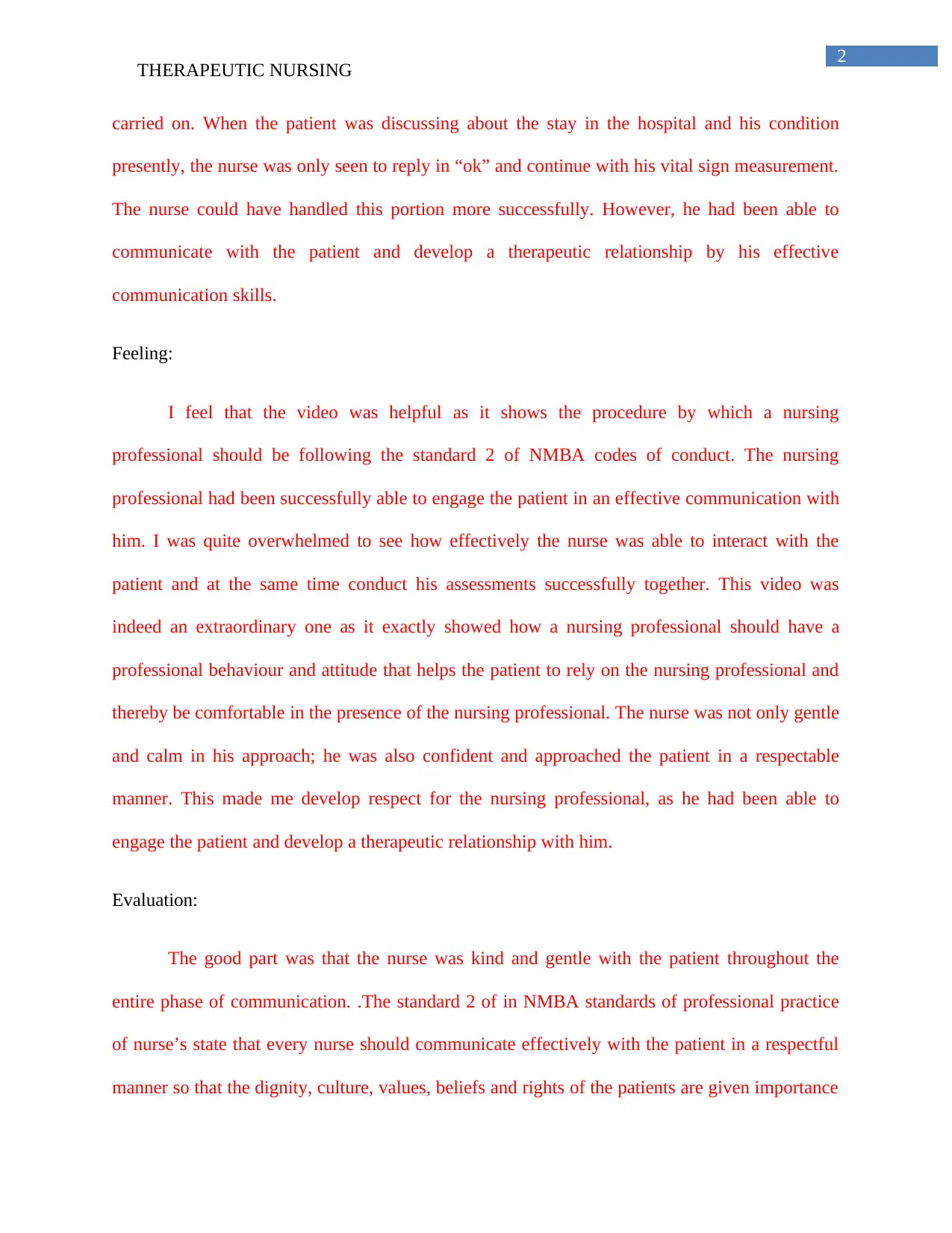
2
THERAPEUTIC NURSING
carried on. When the patient was discussing about the stay in the hospital and his condition
presently, the nurse was only seen to reply in “ok” and continue with his vital sign measurement.
The nurse could have handled this portion more successfully. However, he had been able to
communicate with the patient and develop a therapeutic relationship by his effective
communication skills.
Feeling:
I feel that the video was helpful as it shows the procedure by which a nursing
professional should be following the standard 2 of NMBA codes of conduct. The nursing
professional had been successfully able to engage the patient in an effective communication with
him. I was quite overwhelmed to see how effectively the nurse was able to interact with the
patient and at the same time conduct his assessments successfully together. This video was
indeed an extraordinary one as it exactly showed how a nursing professional should have a
professional behaviour and attitude that helps the patient to rely on the nursing professional and
thereby be comfortable in the presence of the nursing professional. The nurse was not only gentle
and calm in his approach; he was also confident and approached the patient in a respectable
manner. This made me develop respect for the nursing professional, as he had been able to
engage the patient and develop a therapeutic relationship with him.
Evaluation:
The good part was that the nurse was kind and gentle with the patient throughout the
entire phase of communication. .The standard 2 of in NMBA standards of professional practice
of nurse’s state that every nurse should communicate effectively with the patient in a respectful
manner so that the dignity, culture, values, beliefs and rights of the patients are given importance
THERAPEUTIC NURSING
carried on. When the patient was discussing about the stay in the hospital and his condition
presently, the nurse was only seen to reply in “ok” and continue with his vital sign measurement.
The nurse could have handled this portion more successfully. However, he had been able to
communicate with the patient and develop a therapeutic relationship by his effective
communication skills.
Feeling:
I feel that the video was helpful as it shows the procedure by which a nursing
professional should be following the standard 2 of NMBA codes of conduct. The nursing
professional had been successfully able to engage the patient in an effective communication with
him. I was quite overwhelmed to see how effectively the nurse was able to interact with the
patient and at the same time conduct his assessments successfully together. This video was
indeed an extraordinary one as it exactly showed how a nursing professional should have a
professional behaviour and attitude that helps the patient to rely on the nursing professional and
thereby be comfortable in the presence of the nursing professional. The nurse was not only gentle
and calm in his approach; he was also confident and approached the patient in a respectable
manner. This made me develop respect for the nursing professional, as he had been able to
engage the patient and develop a therapeutic relationship with him.
Evaluation:
The good part was that the nurse was kind and gentle with the patient throughout the
entire phase of communication. .The standard 2 of in NMBA standards of professional practice
of nurse’s state that every nurse should communicate effectively with the patient in a respectful
manner so that the dignity, culture, values, beliefs and rights of the patients are given importance
⊘ This is a preview!⊘
Do you want full access?
Subscribe today to unlock all pages.

Trusted by 1+ million students worldwide
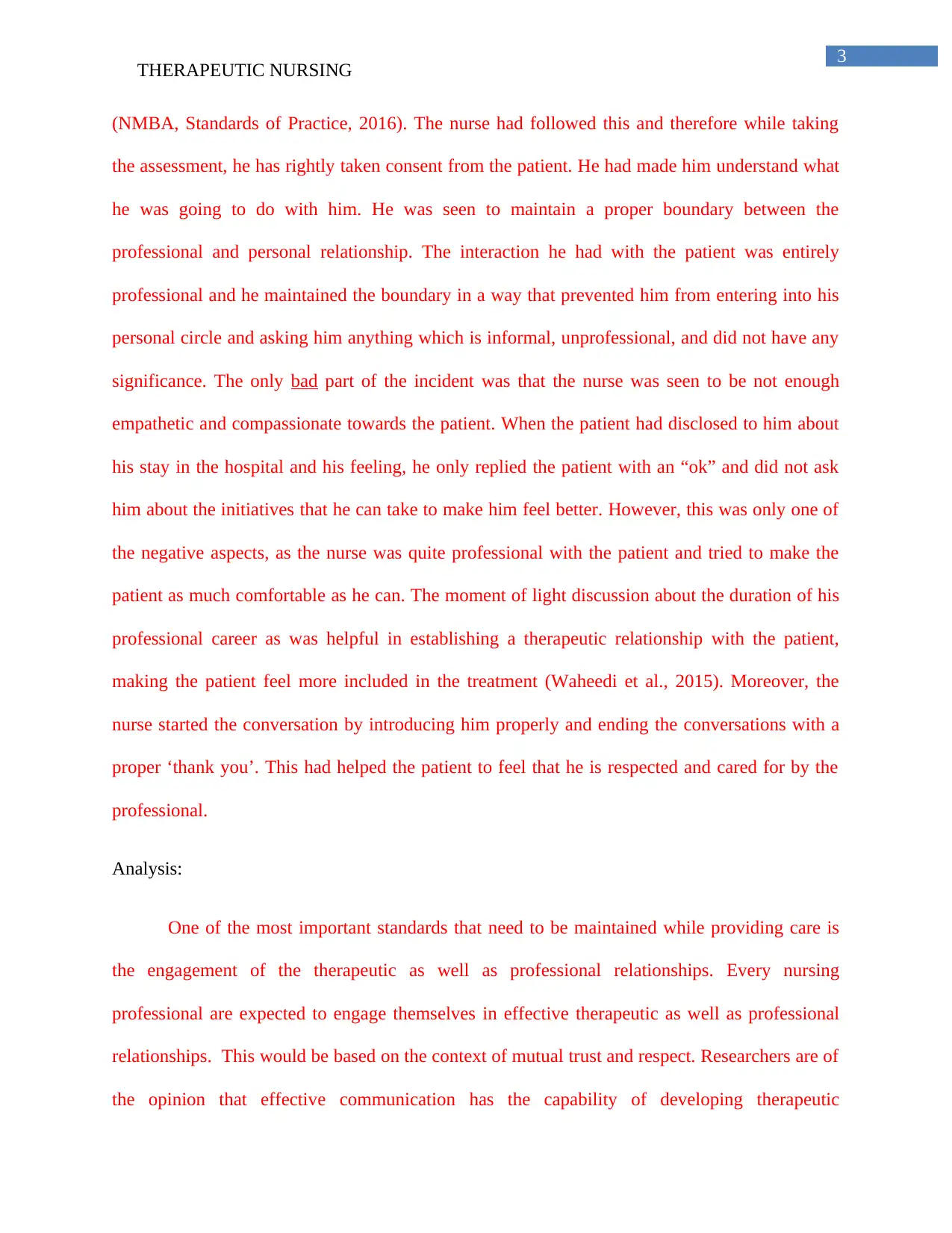
3
THERAPEUTIC NURSING
(NMBA, Standards of Practice, 2016). The nurse had followed this and therefore while taking
the assessment, he has rightly taken consent from the patient. He had made him understand what
he was going to do with him. He was seen to maintain a proper boundary between the
professional and personal relationship. The interaction he had with the patient was entirely
professional and he maintained the boundary in a way that prevented him from entering into his
personal circle and asking him anything which is informal, unprofessional, and did not have any
significance. The only bad part of the incident was that the nurse was seen to be not enough
empathetic and compassionate towards the patient. When the patient had disclosed to him about
his stay in the hospital and his feeling, he only replied the patient with an “ok” and did not ask
him about the initiatives that he can take to make him feel better. However, this was only one of
the negative aspects, as the nurse was quite professional with the patient and tried to make the
patient as much comfortable as he can. The moment of light discussion about the duration of his
professional career as was helpful in establishing a therapeutic relationship with the patient,
making the patient feel more included in the treatment (Waheedi et al., 2015). Moreover, the
nurse started the conversation by introducing him properly and ending the conversations with a
proper ‘thank you’. This had helped the patient to feel that he is respected and cared for by the
professional.
Analysis:
One of the most important standards that need to be maintained while providing care is
the engagement of the therapeutic as well as professional relationships. Every nursing
professional are expected to engage themselves in effective therapeutic as well as professional
relationships. This would be based on the context of mutual trust and respect. Researchers are of
the opinion that effective communication has the capability of developing therapeutic
THERAPEUTIC NURSING
(NMBA, Standards of Practice, 2016). The nurse had followed this and therefore while taking
the assessment, he has rightly taken consent from the patient. He had made him understand what
he was going to do with him. He was seen to maintain a proper boundary between the
professional and personal relationship. The interaction he had with the patient was entirely
professional and he maintained the boundary in a way that prevented him from entering into his
personal circle and asking him anything which is informal, unprofessional, and did not have any
significance. The only bad part of the incident was that the nurse was seen to be not enough
empathetic and compassionate towards the patient. When the patient had disclosed to him about
his stay in the hospital and his feeling, he only replied the patient with an “ok” and did not ask
him about the initiatives that he can take to make him feel better. However, this was only one of
the negative aspects, as the nurse was quite professional with the patient and tried to make the
patient as much comfortable as he can. The moment of light discussion about the duration of his
professional career as was helpful in establishing a therapeutic relationship with the patient,
making the patient feel more included in the treatment (Waheedi et al., 2015). Moreover, the
nurse started the conversation by introducing him properly and ending the conversations with a
proper ‘thank you’. This had helped the patient to feel that he is respected and cared for by the
professional.
Analysis:
One of the most important standards that need to be maintained while providing care is
the engagement of the therapeutic as well as professional relationships. Every nursing
professional are expected to engage themselves in effective therapeutic as well as professional
relationships. This would be based on the context of mutual trust and respect. Researchers are of
the opinion that effective communication has the capability of developing therapeutic
Paraphrase This Document
Need a fresh take? Get an instant paraphrase of this document with our AI Paraphraser
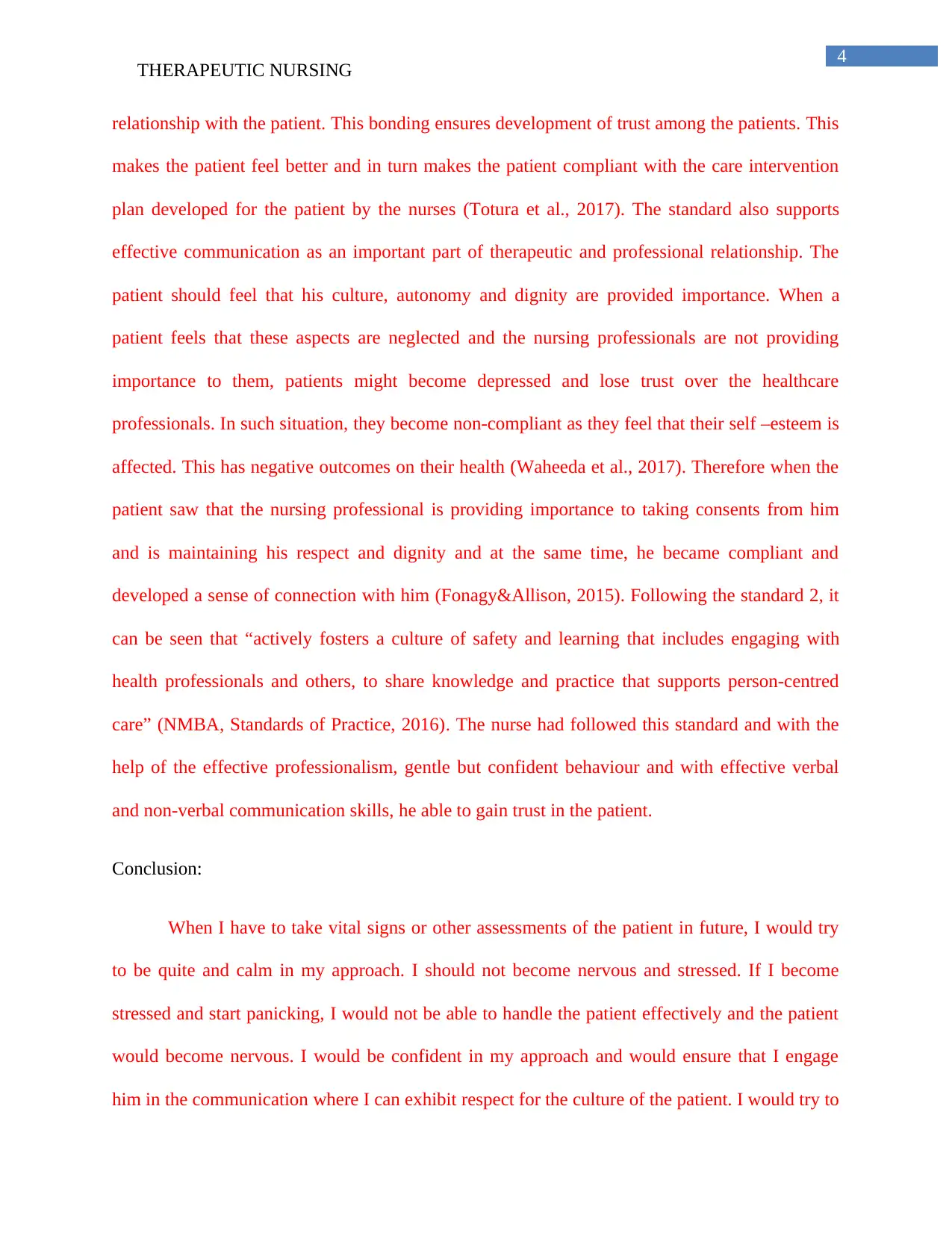
4
THERAPEUTIC NURSING
relationship with the patient. This bonding ensures development of trust among the patients. This
makes the patient feel better and in turn makes the patient compliant with the care intervention
plan developed for the patient by the nurses (Totura et al., 2017). The standard also supports
effective communication as an important part of therapeutic and professional relationship. The
patient should feel that his culture, autonomy and dignity are provided importance. When a
patient feels that these aspects are neglected and the nursing professionals are not providing
importance to them, patients might become depressed and lose trust over the healthcare
professionals. In such situation, they become non-compliant as they feel that their self –esteem is
affected. This has negative outcomes on their health (Waheeda et al., 2017). Therefore when the
patient saw that the nursing professional is providing importance to taking consents from him
and is maintaining his respect and dignity and at the same time, he became compliant and
developed a sense of connection with him (Fonagy&Allison, 2015). Following the standard 2, it
can be seen that “actively fosters a culture of safety and learning that includes engaging with
health professionals and others, to share knowledge and practice that supports person-centred
care” (NMBA, Standards of Practice, 2016). The nurse had followed this standard and with the
help of the effective professionalism, gentle but confident behaviour and with effective verbal
and non-verbal communication skills, he able to gain trust in the patient.
Conclusion:
When I have to take vital signs or other assessments of the patient in future, I would try
to be quite and calm in my approach. I should not become nervous and stressed. If I become
stressed and start panicking, I would not be able to handle the patient effectively and the patient
would become nervous. I would be confident in my approach and would ensure that I engage
him in the communication where I can exhibit respect for the culture of the patient. I would try to
THERAPEUTIC NURSING
relationship with the patient. This bonding ensures development of trust among the patients. This
makes the patient feel better and in turn makes the patient compliant with the care intervention
plan developed for the patient by the nurses (Totura et al., 2017). The standard also supports
effective communication as an important part of therapeutic and professional relationship. The
patient should feel that his culture, autonomy and dignity are provided importance. When a
patient feels that these aspects are neglected and the nursing professionals are not providing
importance to them, patients might become depressed and lose trust over the healthcare
professionals. In such situation, they become non-compliant as they feel that their self –esteem is
affected. This has negative outcomes on their health (Waheeda et al., 2017). Therefore when the
patient saw that the nursing professional is providing importance to taking consents from him
and is maintaining his respect and dignity and at the same time, he became compliant and
developed a sense of connection with him (Fonagy&Allison, 2015). Following the standard 2, it
can be seen that “actively fosters a culture of safety and learning that includes engaging with
health professionals and others, to share knowledge and practice that supports person-centred
care” (NMBA, Standards of Practice, 2016). The nurse had followed this standard and with the
help of the effective professionalism, gentle but confident behaviour and with effective verbal
and non-verbal communication skills, he able to gain trust in the patient.
Conclusion:
When I have to take vital signs or other assessments of the patient in future, I would try
to be quite and calm in my approach. I should not become nervous and stressed. If I become
stressed and start panicking, I would not be able to handle the patient effectively and the patient
would become nervous. I would be confident in my approach and would ensure that I engage
him in the communication where I can exhibit respect for the culture of the patient. I would try to
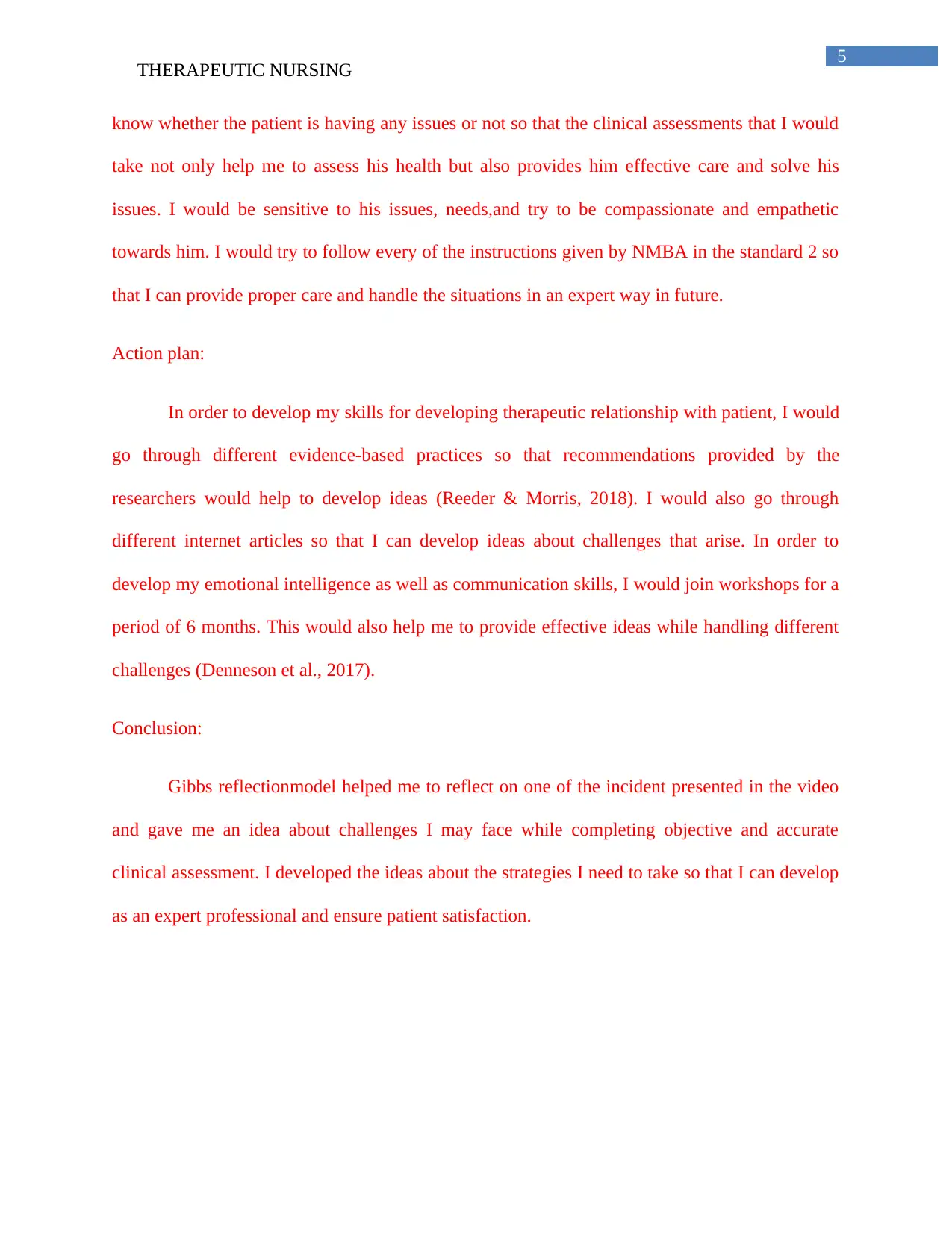
5
THERAPEUTIC NURSING
know whether the patient is having any issues or not so that the clinical assessments that I would
take not only help me to assess his health but also provides him effective care and solve his
issues. I would be sensitive to his issues, needs,and try to be compassionate and empathetic
towards him. I would try to follow every of the instructions given by NMBA in the standard 2 so
that I can provide proper care and handle the situations in an expert way in future.
Action plan:
In order to develop my skills for developing therapeutic relationship with patient, I would
go through different evidence-based practices so that recommendations provided by the
researchers would help to develop ideas (Reeder & Morris, 2018). I would also go through
different internet articles so that I can develop ideas about challenges that arise. In order to
develop my emotional intelligence as well as communication skills, I would join workshops for a
period of 6 months. This would also help me to provide effective ideas while handling different
challenges (Denneson et al., 2017).
Conclusion:
Gibbs reflectionmodel helped me to reflect on one of the incident presented in the video
and gave me an idea about challenges I may face while completing objective and accurate
clinical assessment. I developed the ideas about the strategies I need to take so that I can develop
as an expert professional and ensure patient satisfaction.
THERAPEUTIC NURSING
know whether the patient is having any issues or not so that the clinical assessments that I would
take not only help me to assess his health but also provides him effective care and solve his
issues. I would be sensitive to his issues, needs,and try to be compassionate and empathetic
towards him. I would try to follow every of the instructions given by NMBA in the standard 2 so
that I can provide proper care and handle the situations in an expert way in future.
Action plan:
In order to develop my skills for developing therapeutic relationship with patient, I would
go through different evidence-based practices so that recommendations provided by the
researchers would help to develop ideas (Reeder & Morris, 2018). I would also go through
different internet articles so that I can develop ideas about challenges that arise. In order to
develop my emotional intelligence as well as communication skills, I would join workshops for a
period of 6 months. This would also help me to provide effective ideas while handling different
challenges (Denneson et al., 2017).
Conclusion:
Gibbs reflectionmodel helped me to reflect on one of the incident presented in the video
and gave me an idea about challenges I may face while completing objective and accurate
clinical assessment. I developed the ideas about the strategies I need to take so that I can develop
as an expert professional and ensure patient satisfaction.
⊘ This is a preview!⊘
Do you want full access?
Subscribe today to unlock all pages.

Trusted by 1+ million students worldwide
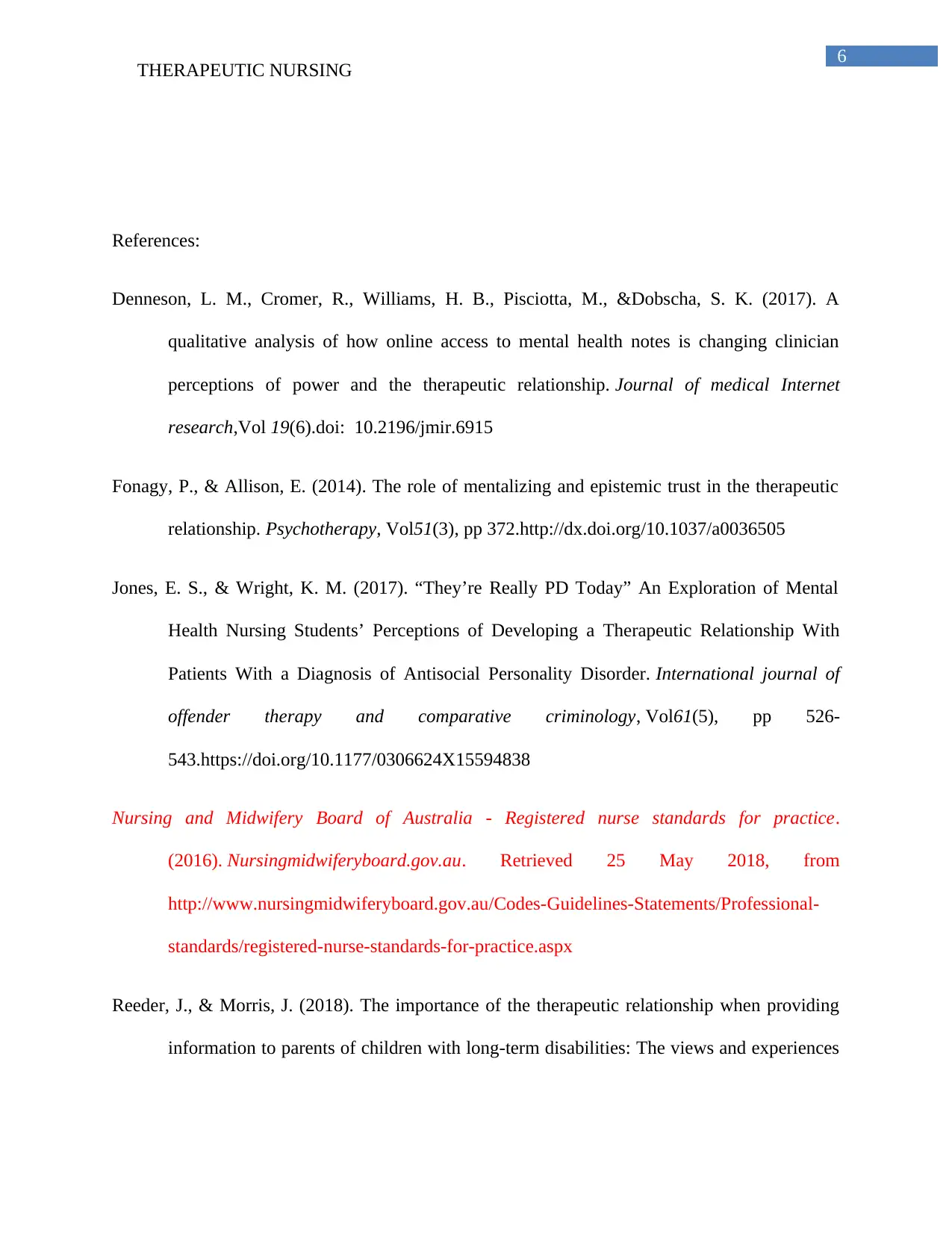
6
THERAPEUTIC NURSING
References:
Denneson, L. M., Cromer, R., Williams, H. B., Pisciotta, M., &Dobscha, S. K. (2017). A
qualitative analysis of how online access to mental health notes is changing clinician
perceptions of power and the therapeutic relationship. Journal of medical Internet
research,Vol 19(6).doi: 10.2196/jmir.6915
Fonagy, P., & Allison, E. (2014). The role of mentalizing and epistemic trust in the therapeutic
relationship. Psychotherapy, Vol51(3), pp 372.http://dx.doi.org/10.1037/a0036505
Jones, E. S., & Wright, K. M. (2017). “They’re Really PD Today” An Exploration of Mental
Health Nursing Students’ Perceptions of Developing a Therapeutic Relationship With
Patients With a Diagnosis of Antisocial Personality Disorder. International journal of
offender therapy and comparative criminology, Vol61(5), pp 526-
543.https://doi.org/10.1177/0306624X15594838
Nursing and Midwifery Board of Australia - Registered nurse standards for practice.
(2016). Nursingmidwiferyboard.gov.au. Retrieved 25 May 2018, from
http://www.nursingmidwiferyboard.gov.au/Codes-Guidelines-Statements/Professional-
standards/registered-nurse-standards-for-practice.aspx
Reeder, J., & Morris, J. (2018). The importance of the therapeutic relationship when providing
information to parents of children with long-term disabilities: The views and experiences
THERAPEUTIC NURSING
References:
Denneson, L. M., Cromer, R., Williams, H. B., Pisciotta, M., &Dobscha, S. K. (2017). A
qualitative analysis of how online access to mental health notes is changing clinician
perceptions of power and the therapeutic relationship. Journal of medical Internet
research,Vol 19(6).doi: 10.2196/jmir.6915
Fonagy, P., & Allison, E. (2014). The role of mentalizing and epistemic trust in the therapeutic
relationship. Psychotherapy, Vol51(3), pp 372.http://dx.doi.org/10.1037/a0036505
Jones, E. S., & Wright, K. M. (2017). “They’re Really PD Today” An Exploration of Mental
Health Nursing Students’ Perceptions of Developing a Therapeutic Relationship With
Patients With a Diagnosis of Antisocial Personality Disorder. International journal of
offender therapy and comparative criminology, Vol61(5), pp 526-
543.https://doi.org/10.1177/0306624X15594838
Nursing and Midwifery Board of Australia - Registered nurse standards for practice.
(2016). Nursingmidwiferyboard.gov.au. Retrieved 25 May 2018, from
http://www.nursingmidwiferyboard.gov.au/Codes-Guidelines-Statements/Professional-
standards/registered-nurse-standards-for-practice.aspx
Reeder, J., & Morris, J. (2018). The importance of the therapeutic relationship when providing
information to parents of children with long-term disabilities: The views and experiences
Paraphrase This Document
Need a fresh take? Get an instant paraphrase of this document with our AI Paraphraser
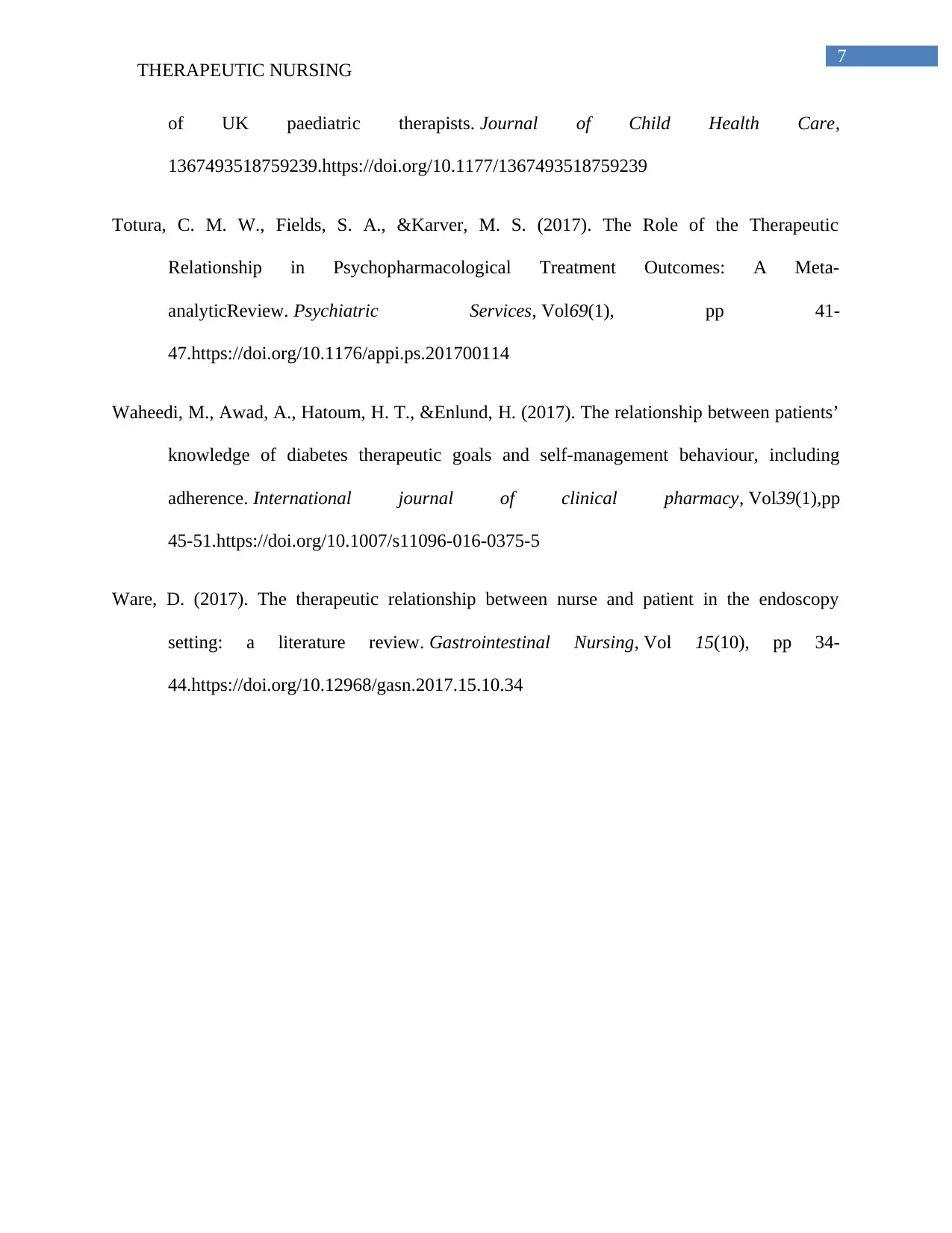
7
THERAPEUTIC NURSING
of UK paediatric therapists. Journal of Child Health Care,
1367493518759239.https://doi.org/10.1177/1367493518759239
Totura, C. M. W., Fields, S. A., &Karver, M. S. (2017). The Role of the Therapeutic
Relationship in Psychopharmacological Treatment Outcomes: A Meta-
analyticReview. Psychiatric Services, Vol69(1), pp 41-
47.https://doi.org/10.1176/appi.ps.201700114
Waheedi, M., Awad, A., Hatoum, H. T., &Enlund, H. (2017). The relationship between patients’
knowledge of diabetes therapeutic goals and self-management behaviour, including
adherence. International journal of clinical pharmacy, Vol39(1),pp
45-51.https://doi.org/10.1007/s11096-016-0375-5
Ware, D. (2017). The therapeutic relationship between nurse and patient in the endoscopy
setting: a literature review. Gastrointestinal Nursing, Vol 15(10), pp 34-
44.https://doi.org/10.12968/gasn.2017.15.10.34
THERAPEUTIC NURSING
of UK paediatric therapists. Journal of Child Health Care,
1367493518759239.https://doi.org/10.1177/1367493518759239
Totura, C. M. W., Fields, S. A., &Karver, M. S. (2017). The Role of the Therapeutic
Relationship in Psychopharmacological Treatment Outcomes: A Meta-
analyticReview. Psychiatric Services, Vol69(1), pp 41-
47.https://doi.org/10.1176/appi.ps.201700114
Waheedi, M., Awad, A., Hatoum, H. T., &Enlund, H. (2017). The relationship between patients’
knowledge of diabetes therapeutic goals and self-management behaviour, including
adherence. International journal of clinical pharmacy, Vol39(1),pp
45-51.https://doi.org/10.1007/s11096-016-0375-5
Ware, D. (2017). The therapeutic relationship between nurse and patient in the endoscopy
setting: a literature review. Gastrointestinal Nursing, Vol 15(10), pp 34-
44.https://doi.org/10.12968/gasn.2017.15.10.34
1 out of 8
Related Documents
Your All-in-One AI-Powered Toolkit for Academic Success.
+13062052269
info@desklib.com
Available 24*7 on WhatsApp / Email
![[object Object]](/_next/static/media/star-bottom.7253800d.svg)
Unlock your academic potential
Copyright © 2020–2025 A2Z Services. All Rights Reserved. Developed and managed by ZUCOL.




